





Although I am sure many of you will enjoy this Trip Report of a W17 at sea, as designer of the boat, I do have to point out that owner/boatbuilder Andrew is a fairly aggressive Australian sailor, who enjoys to push things to the limit and who openly admits that he is using this boat knowingly beyond its intended use and designed range. But it's good to realize that he also equips his boats with some degree of redundancy in case of failures and recommends that anyone else planning to undertake such small-boat, long trips in open water, far from help, should plan similarly. If you push too hard, of course something can break but you don't want that to stop you returning home in one piece, so plan wisely and always sail within your means and experience—and for such adventurous trips, it's always wise to do so in the company of at least one other boat. So even though it's encouraging to see what this boat can do, please be prudent.
mike waters—January 2011
8-Day Christmas Cruise – Lucena to Leah Beach, Batangas
W17 trimaran called "Pegasus"
Distance 200 nautical miles
Day 1 — Lucena, Batangas to St Cruz, Marinduque Island
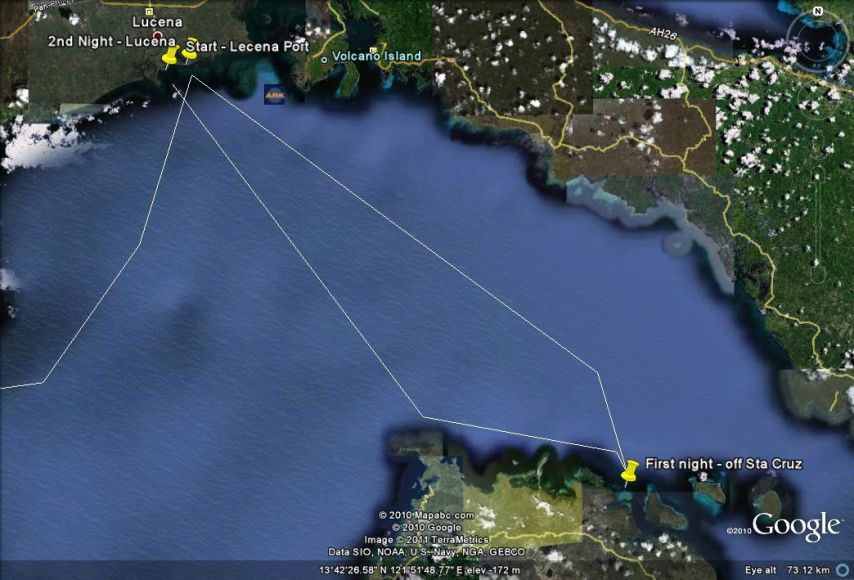
23 nm
We left the Melvest Marine factory, Taytay at 5 am and drove to Lucena. We spent 2 hours looking for a suitable place to launch the boat. This can be a real problem as there are no ramps anywhere for launching trailer sailers. Eventually we launched the W17 on the wharf at the Lucena Port. Many fishermen helped us rig the boat and put it in the water. Of course 2 bottles of rum were required to help with their Christmas celebrations afterwards.
I was frustrated at the time it had taken to travel and get on the water and did not want to fall behind schedule on my trip. So after a quick tack back and forth in the port to check everything and to give a thumbs up to my workers assisting me with the transport and launch, I set off under full main and jib on a beam reach heading for Marinduque. The wind increased from 15 k to 18 gusting to 20 k so I took in a reef. The boat was happily flying along at 10 knots with me taking shelter in the cockpit. I had decided not to put myself out on the amas while sailing alone in case I fell off. So the whole trip was done with me inboard.
I arrived at the NW tip of Marinduque by 4 pm. Then I reached along the coast toward the NE tip and St. Cruz anchorage.
While halfway along the northern coast of Marinduque and while sailing a mile off shore, at the lowest point between two waves, the daggerboard hit the bottom. The contact was only the smallest of grinding caresses but alarming never the less. So I then headed further out to sea.
One hour later and I was near but I ran out of light. This was the first lesson I learnt on this trip. Plan to arrive early at the next anchorage. Never arrive at night! As the sun went down, I could see islands to the east and a fishing boat coming out of the channel I should have gone in on to get to my anchorage but there was not enough light left for me to navigate. I didn't know the area at all. So I had to choose between sailing off shore all night or dropping anchor in front of a lee shore with 5 ft swells and 18 knots winds buffeting me. Fortunately, I had a new 10 lb Danforth anchor with 2 metres of heavy chain on it. So I put the anchor over the side in about 10 metres of water. The anchor held so I settled down to sleep as best I could in the bottom of the boat wearing my raincoat with two wet sailbags for blankets. I didn't sleep much. I was really just waiting for the sun to come up. I actually felt so miserable, cold and even nauseated after a night riding such large swells, that I was thinking my trip might be over before it hardly started! [A great sail the next day soon brushed that thought aside though.]
Day 2 — St Cruz, Marinduque Island back to Lucena, Batangas
See map above In the morning, I was very glad I stayed put. They anchor had held fast all night but I could not pull it up. After trying several times, I cut it loose. But before I cut it free, I had a good long think. I realised that I could not go on to Romblon without an anchor and cutting it free meant I would have to return to Lucena and buy another anchor. So at 7.15 am I set sail for Lucena.
In the morning, I was very glad I stayed put. They anchor had held fast all night but I could not pull it up. After trying several times, I cut it loose. But before I cut it free, I had a good long think. I realised that I could not go on to Romblon without an anchor and cutting it free meant I would have to return to Lucena and buy another anchor. So at 7.15 am I set sail for Lucena.
At 1 pm I arrived back in the port and sailed along the coast looking for fisherman with bankas on the beach. I picked a spot in protected waters behind a sandy point and went ashore. It was not long before I had many fisherman and children crowding, intrigued by their look at a W17 for the first time. I asked for someone to sell me a local fisherman's anchor and the negotiations began. Half way through, I realised I needed some hot food as well, so negotiated lunch and dinner into the deal. The anchor offered to me was a fine example of local ingenuity. The anchor was damaged and had to be welded before we could finalise the deal. No problem, everything was settled within the hour.
Lunch was pork adobo on rice and dinner was chicken afritarda. Between lunch and dinner I set up the tent over the boom. The tent was good and provided a large area of cover over the boat. The only problem was the front was open to the wind and rain! So I made a note to fix that on my return. For now, I had to sleep with my raincoat over my head. The tide was due to be well out in the morning so after lifting anchor and drifting out a good distance, I set the anchor again and turned in early. After the previous night I slept like a log.
Day 3 — Lucena to Laiya, Batangas
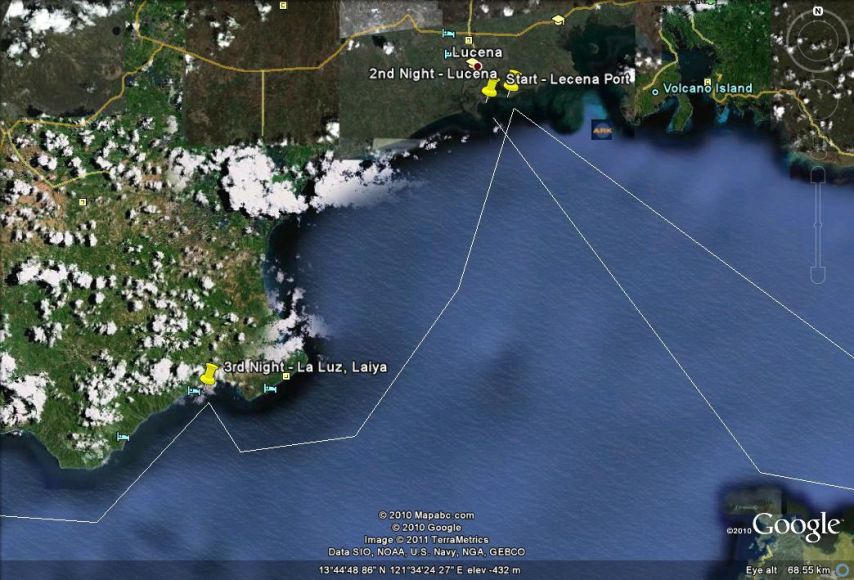
Not wanting to be caught out at sea at night again, I broke the journey to Puerto Galera into two legs. The first leg to Laiya was only 25 miles so I set off quietly under jib alone at 8 am and took my time eating breakfast and getting shipshape before I left Lucena Bay. The winds were 8 knots from the NE increasing gradually and the tide was way out.
Fortunately, the jib only slowed the boat down to 3 to 4 knots and I had no daggerboard down. While eating my breakfast and not really paying attention, I happily sailed out between all the bankas now doing their early morning fishing. As there were little boats all around me, I wrongly assumed there was no danger. I was actually directly on course to run up onto a barely submerged reef. At the last minute, the rudder grounded and when I looked up there were little black rocks sticking up like big teeth only 30 metres ahead! I released the rudder hold down line in case I hit something really solid and put the helm over. I hit something under the middle of the boat but Pegasus rode right over the top. Lucky.
I then realised that many of the fisherman were actually standing besides their boats on the rocks while they did their work! Maybe they were collecting bait.
I later found on the chart a warning about a reef directly SW of Lucena Port. Lesson number 2 assume nothing! Look at the chart.
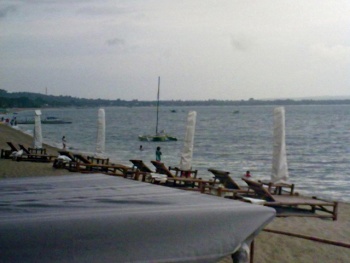 The sailing was very pleasant from then on. By midday, I had arrived at Laiya and a beautiful bay it is too. I was so taken with it, that I decided to sail the full length of the beach from East to West looking at the shoreline on my way to the intended anchorage at La Luz. While 500 metres off shore, I hit the bottom again with a very big bang. The boat lurched and the daggerboard jumped and rotated in the slot. Wow! Third time I have hit the bottom in two days! No warning and nothing on the chart this time. But as the daggerboard pivoted, neither the board nor the boat sustained any damage.
The sailing was very pleasant from then on. By midday, I had arrived at Laiya and a beautiful bay it is too. I was so taken with it, that I decided to sail the full length of the beach from East to West looking at the shoreline on my way to the intended anchorage at La Luz. While 500 metres off shore, I hit the bottom again with a very big bang. The boat lurched and the daggerboard jumped and rotated in the slot. Wow! Third time I have hit the bottom in two days! No warning and nothing on the chart this time. But as the daggerboard pivoted, neither the board nor the boat sustained any damage.
I had a few beers at La Luz but they would not feed me without booking accommodation. I was determined to sleep on the boat so I walked along the shore until I found a local restaurant selling Filipino food. I also purchased a bottle of Tanduay rum. This local rum is famous and for many years it was only US$1 per bottle. It is now a US$1.50 so it is still good value. I thought that all sailors carried rum on their expeditions and I didn't want to let the side down.
As I had been caught in the drizzle the last two nights, I decided to sleep in the cockpit floor Australian swagman style. I put foam in the bottom of the boat so any slop from the daggerboard would not wet me and then laid the tent down in the bottom of the boat so that it could overlap my mattress and sleeping bag at the top. I then made a shelter for my head with more foam. 5mm latex foam is readily available here and is a stiff enough to hold some shape. Like this, I was as dry as a bone all night and slept very well.
Day 4 — Laiya to Puerto Galera, Mindoro Island
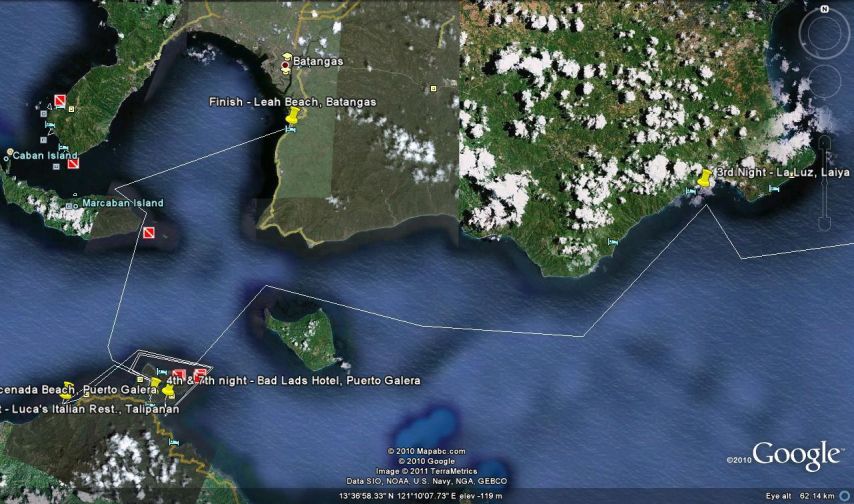
This was a very pleasant sail before a 15 knot breeze from the NE until the wind gave out at 11.00 am. I was reminded of some trips in this area where there was no wind for hours and hours. Lack of wind usually occurs between the trade wind seasons when the patterns are not yet set and the wind can't make up its mind which way to blow.
The motion was very uncomfortable as the 3‑ft swell without the steadying influence of the wind rocked the boat back and forth flapping the sails and churning my stomach. As there was the tiniest breath of wind, I decided to sail on a close reach in the wrong direction to steady the boat. After 30 mins of this, the wind returned.
Arrived Puerto Galera at 2 pm. There are two channels into the bay and I elected to sail in via the Manila Channel that runs NW to SE as it should have given me a nice breeze in. I was wrong however and should have sailed in on the other one called the Batangas Channel that runs N to S. The Manila Channel had high cliffs either side which altered the wind direction, so I had to beat in.
Puerto Galera is a famous pirate port from the old days. The Spanish soon cleared out the pirates and claimed it for themselves as it is one of the best places in the Philippines to ride out a typhoon. In more recent times, I visited Puerto Galera in 1981 to go SCUBA diving. We booked a dive with an Australian diving operator there and went back in the morning only to find all the Australian divers had been arrested for smuggling. As it turns out, they had some weeks before found a sunken Spanish galleon with chests full of gold coins and when the authorities found out, they were very angry because they didn't get any! Those two Australian divers are still in the Philippines today. They are now living legends.

I was able to go behind all the other yachts on their moorings and anchor between them and the mangroves. The water was only 5 ft deep but that is plenty deep enough for the W17 and there is not much competition for shallow water from keel boats.

My view of the PGYC moorings from Bad Lads Hotel. Can you see that tiny boat close to the mangroves, just above the little Philippine flag right in the middle of the picture?
Day 5 — Puerto Galera to Encenada Beach, Mindoro


This day was just a short trip to explore the back of Puerto Galera port. The local tourist map suggested a beautiful little anchorage sheltered from the NE winds. So I went to see and found the PGYC had finished their Christmas regatta here and were having a party on the beach. So I joined in and ended up staying the night as the guests of two Australian geologists.
This was the view of the boat from my bed.
Day 6 — Encenada Beach to Luca's Italian Restaurant, Talipanan

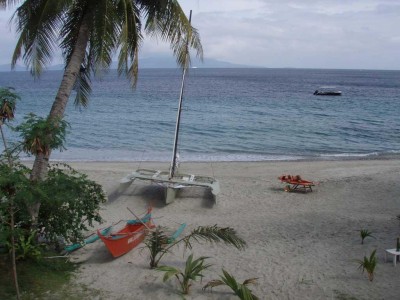
Winds 15 knots from the NE. I enjoyed another very pleasant sail along the coast past PG again to just past the famous tourist destination of White Beach. White Beach is famous for a mile long beach of white sands (obviously) with wall to wall bars, hotels, night clubs and restaurants.Just past White Beach at the end of the local road is a place called Talipanan Point. Here there is an Italian restaurant famous for the best pizza in the Philippines. So I just had to go there! I was not disappointed and spent New Years Eve here watching the magnificent fireworks display emanating from White Beach. The pizzas are very large and are roughly square in shape. They have a thin slightly crusty base with no sugar added. The toppings were just what you would expect of an Italian pizza and I regret not taking a picture. A note here on the local food: Just about all Filipino food is loaded with sugar. The local Coca Cola has extra sugar in it, bread has sugar in it, iced tea is very sweet and Filipinos find sweet wine too sour!. Pizza here normally also has sugar in it, that is why Luca's authentic pizza is such a find. It is the real thing.
Just offshore from Luca's hotel, the boat would have been at anchor in a fairly exposed position with the NE trades blowing along parallel to the beach.
To remove any concerns while I slept ashore in Luca's Hotel bed, 7 people picked the boat up and put it on the sand well above the high water mark. You can see from the pictures that it was an ideal setting. So from the restaurant and the balcony of my hotel room, I could see the boat safely resting on the sand.

Luca's Italian Restaruant in the background
Day 7 — Talipanan to Puerto Gallera
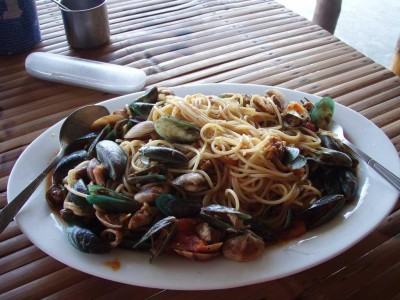
For breakfast I enjoyed spaghetti marinara. This is my father's favourite Italian dish so I like to sample it where ever I go so I can report back to him. This time I took a picture and you can see it is delicious. All the added seafood was local and very fresh.

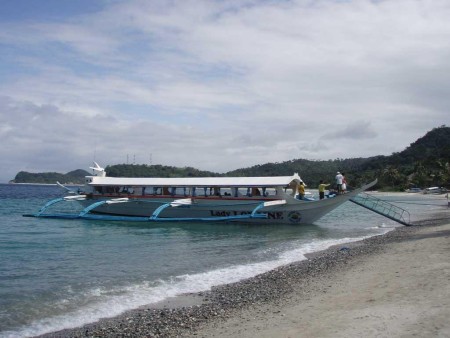
The boat being on the beach, I had to wait for people to wake up after celebrating the New Year's Eve. So I went for a walk to explore the local scene. I had heard that a famous custom banka builder normally made boats to order - right there on the beach. So I set off to find him. Unfortunately, he was away visiting his family and was also between boat orders so I did not get to meet him or see his work but I found another boat builder making modifications to an existing banka. We got to talking and this builder offered to build me an 18ft banka complete with Briggs and Stratton 8 hp inboard engine, outriggers, sunshade all fully painted for Peso 100,000. This is about US$2,200. This man lived on the beach in that hut on the left. His family numbered about 12 including grandchildren.
Upon my return from my walk up the beach, Pegasus was already floating at anchor. So I quickly paid my hotel bill and cast off. With the usual 15 knots of wind from the NE, I returned to PG in the afternoon to spend the last night of my holiday at Bad Lads Hotel.
Most people come to Puerto Galera on local bankas. They operate like buses and are extremely versatile. They can land their customers almost anywhere and require no onshore facilities. Just make sure you are not on one in a storm! In view of their lack of seaworthiness, they are only allowed to operate during daylight hours so the last ferry leaves for Batangas at 4 pm each day.
That evening, while looking for a pre-dinner drink, I again ran into the sailors from the PGYC at one of their favourite bars—Rock'N Roll Bar also owned by an Australian. The bar owner told me he was a "Chippy with bad knees" (a carpenter by trade) and while on a holiday there, he got sweet talked into buying the bar. He is a thoroughly nice man and the service there which includes internet café rentals, food and beverages is very good. Anyway, in the company of the sailors, I met a crazy Englishman who had arrived in PG two hours into the New Year from the far south. Entering PG at night is very scary as the channels are very narrow and reefs line the shores. Gary and his charming girlfriend had been beating up the West coast of this island of Mindoro for days to get here in time for the fireworks etc. They are very hardy souls indeed. They invited me to dinner in Sabang the nearby town where most of the SCUBA dive tours operate from and consequently there are heaps of bars, restaurants and hotels there. They were looking for a restaurant called Hemingway's. We found it and enjoyed some really excellent rare beef. But I was very disappointed to discover the staff had no idea who Ernest Hemingway was. Along the way, we also found a German castle. When Gary said someone had built a medieval castle in Sabang, I didn't believe him so he showed me. It is built on the side of a very steep hill just on the side of the main street into Sabang. Quite extraordinary!
Day 8 — Puerto Gallera to Leah Beach, near Batangas City
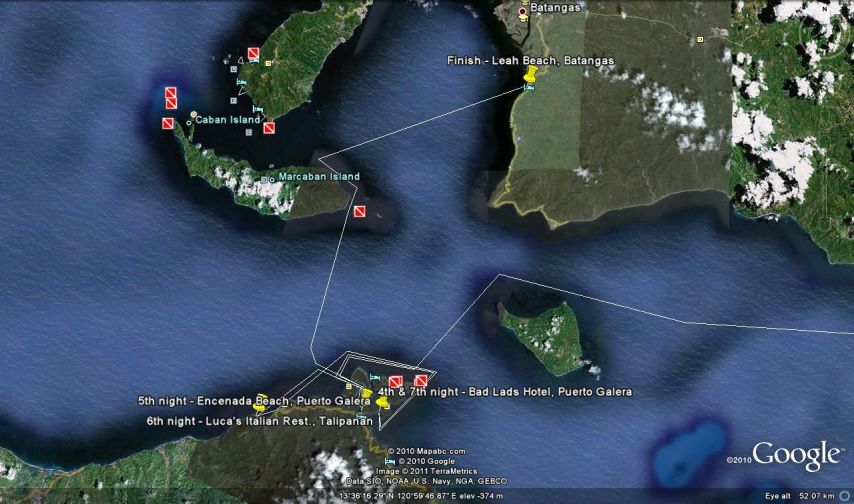
Wind 18 k from NE. Left Puerto Galera at 9.00 am. Once out of the harbour, I set the sails for a broad reach across Verde Passage. The W17 flew along nicely and the crossing was completed in only one hour. As the crossing proceeded, the waves got bigger and bigger. For the last 5 miles, I was picking waves to catch. When a big one appeared, say 5 ft, I would run downwind on its face and surf for a whole minute. Great fun.
Once inside Batangas Bay, I sailed around into the passage between Marcaban Is. And the Luzon mainland. I wanted to see if that was a useable passage when beating in to the NE winds on the way from Manila to Puerto Galera. The currents in the Verde Passage can be very strong towards the west and I was looking for a way to bypass the worst of it. Plenty of room in there but winds could be very unreliable as the land is high either side.
Then I turned around and beat into the wind all the way to Leah Beach. The winds seemed much stronger so I took in a reef. The boat handled very well and by 2 pm I arrived.
UPON REFLECTION
The W17 is a very comfortable and safe boat to go cruising in. I guess you would call it a micro cruiser but my trip convinced me that this sort of sailing can safely be carried out in this boat. At no time did I feel unsure of the boat and it never felt like capsizing. The stability is very high indeed. Camping on the boat greatly reduces the cost of the holiday and I really enjoyed the independence. The ability to pull it out of the water means you can escape really bad weather and even leave the boat if you wish to explore without concern for an anchor letting go. I hasten to add that in the Philippines you can never leave a boat without someone watching it for you but that is so easily arranged.
While doing this fairly lengthy trip on the W17, an important thought came back to me repeatedly. It was that a stable, seaworthy little boat like this can indeed allow those with less funds at their disposal, to still fulfill some of their sailing dreams if they are ready to rough things a little ie: camping style, without necessarily waiting for a bigger boat. Although crews have on rare occasion, done such trips on beach-cats such as a Hobie 16 or 18, the W17 certainly offers to do it more comfortably, as well as staying drier, providing more storage space, and most importantly, with less risk of capsize.
I had made for this trip, two spray catchers that looked a bit like mini bow nets. These nets are made from truck tarpaulin and, as Mike had promised, made a huge difference to any spray coming into the boat. In fact the boat is now very dry to sail and only the occasional wave slapping the sides in an unexpected manner results in any water coming aboard at all.
I am now looking to improve the sleeping arrangements and will probably suspend two hammocks in the cockpit. My tent also needs weather proofing at the bow end. When next planning a trip, because I carry no outboard, I will shorten the days travel to suit the winds. Getting up very early and getting to a safe anchorage before midday might then leave another leg available in the afternoon. But in any event, I will allow for at least two hours a day of no wind in any planning I do in future. And I will always take at least one anchor with chain on it and plenty of line. But a really fun cruise that has me already thinking of new ones.
Andrew — January 2011
"See the Copyright Information & Legal Disclaimer page for copyright info and use of ANY part of this text or article"